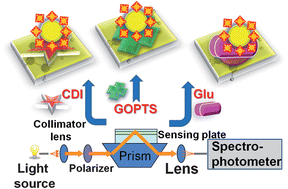The surfaces of silica-based sensor chips, designed for evanescent-field-coupled waveguide-mode sensors, were functionalized using various surface chemistries. The immobilization of molecular entities on the functionalized silica surfaces was monitored using various microscopic techniques (scanning electron, fluorescence, and atomic force microscopies). Further, gold nanoparticle-based signal enhancement analyses were performed with protein conjugation on different functionalized surfaces using a waveguide-mode sensor. Based on these analyses, the sensor surfaces modified with glutaraldehyde (Glu) and carbonyldiimidazole were found to be good for molecules of different sizes. In addition, it can be inferred that the Glu-modified surface may be suitable for small molecules with diameters around 5 nm owing to its surface roughness. The modified surface with carbonyldiimidazole is suitable for the direct immobilization of larger molecules especially for biomolecular assemblies without intermediate chemical modifications.

You have access to this article
 Please wait while we load your content...
Something went wrong. Try again?
Please wait while we load your content...
Something went wrong. Try again?


 Please wait while we load your content...
Please wait while we load your content...